[ Outlands ] [ Spirelands | Ringlands | Gate-Towns | Hinterlands | Splinterlands | Underlands ]
The Terrain of the Outlands
Location: Outlands / Spirelands, Ringlands and Brinklands
So I’m guessing you already know about how travelling one way between two gate towns might take three days and the return journey eighteen? Now bear in mind, you’re travelling the same road, with the same horse and wagon, at what feels like the same speed—but somehow, it takes you six times as long. The thing is, you’ll see different terrain on the way too; maybe on the way there it’s all forest and rolling hills. On the way back, there’s a sodding desert and a marsh. Same road.
Perhaps even stranger though, no matter how the lands in between are changing, the relative locations of the burgs you’re travelling between stays the same. The road itself might look different but you’ll pass the same number of junctions leading off to other places; the way markers might be chiselled in stone one time and simple wooden posts the next, but the signs will point to the same places.
And yet, nobody sees these changes happen. The chant goes that the Outlands shift at night, under the cover of darkness, and only when nobody’s keeping an eye out. A perceptive cutter can hear it though; you might be resting in a tent by a campfire, and in the dead of night you can hear the trees pull up their roots and walk away. Or you might hear the wet slither of a river as it winds its way towards where you’re camped. You might pitch up on a rugged cliff edge one evening and be woken up by sweet scent from the base of a flower-filled valley the following dawn. The first few times it happens you can bet it’ll scare the daylights outa you, but like all things on the planes, a blood gets used to it after a while. It doesn’t seem like the Outlands does anything malicious-like; nobody’s ever woken up being drowned or buried or in a spike-filled pit. At least, nobody that survived to tell the tale, eh? But all the same, it’s unsettling and frankly, outlandish.
Now the terrain seems more stable around places with people—be they planars, petitioners or powers. The presence of a conscious and even semi-intelligent mind seems to stabilise the land. Ribcage will always be found in a hellish valley with wickedly spiked bone-mountains. (Well—never say always—because we all know that a burg can slide between planes, but that one can be chalked up to belief.) Perhaps the reason the Outlands terrain shifting is so unsettling is because it’s the lack of belief that allows the plane to get away with it when it thinks nobody is looking.
Caverns
Caverns dot the Outlands, from small caves to giant subterranean systems, naturally-occurring tunnels carved by underground rivers, lava tubes or simply great fissures in the land caused by its constant movement. Caverns in the Outlands can be enormous, large enough to house whole cities of chthonic creatures, with stalagmites and stalactites thicker than the largest oak trees. The deepest of these tunnels pierce the planar boundary and emerge into the Underlands.
Cloudlands
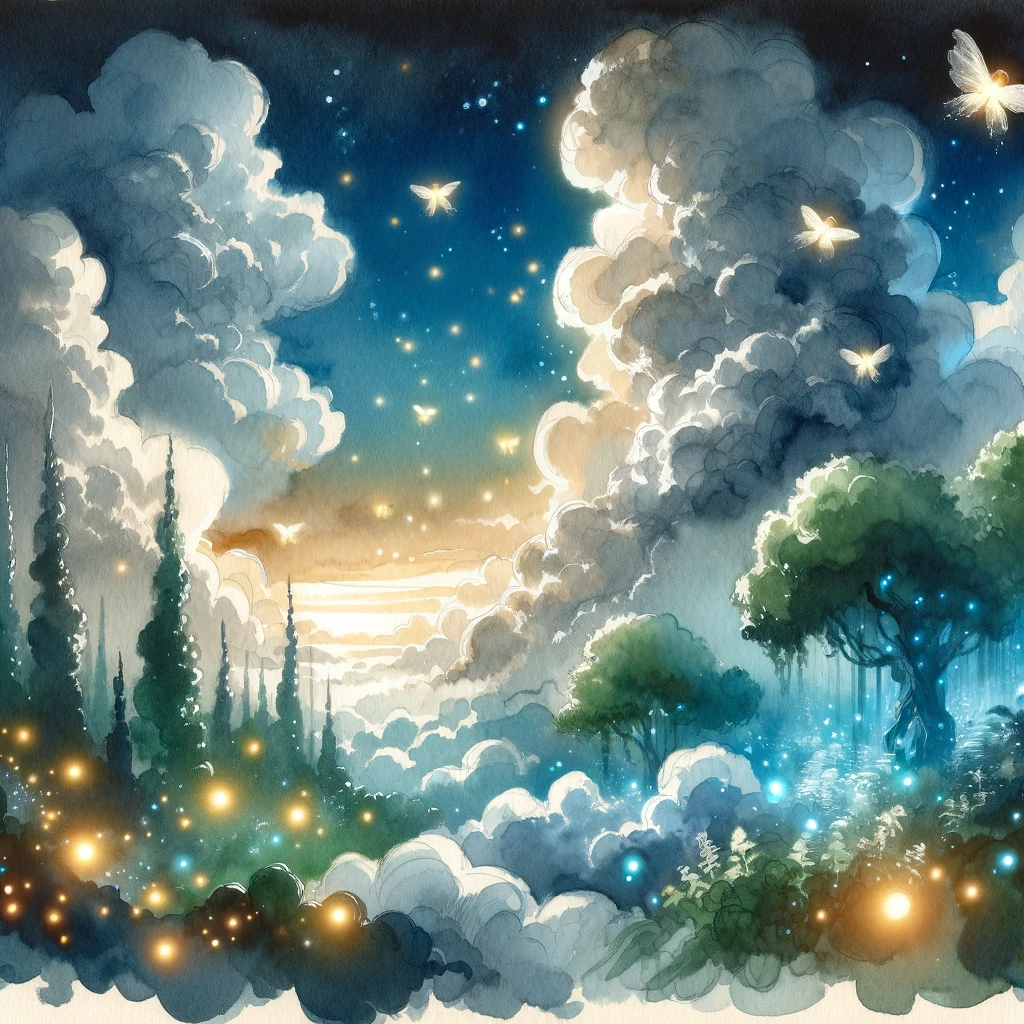
Cloudscapes, or the cloudlands, are luminous terrain high in the skies, formed from semi-solid clouds that emit their own surreal light. Inhabitants here are creatures who have adapted to this ever-shifting environment with its strange ecosystem of verdant ethereal forests and glowing insects. While the Ringlands below are darkened by layers of cloud above the glittering cloudlands bask in the unfettered glow that comes from the skies of the Outlands, and of course it never rains up there. The Storm Cloud castle of Ramman is a typical example of a cloudland realm.
Craters
Craters can be found in unexpected places across the Outlands; they’re remnants of stray fireballs from the month of Hecatomb, markers of particularly violent episodes of the Blood War, or the even damage left when corrupted celestials are kicked out of the Upper Planes and fall hard. Many craters have residual magical, divine or chaotic energies, and crackle with wild magic or magic-dead auras.
Deserts
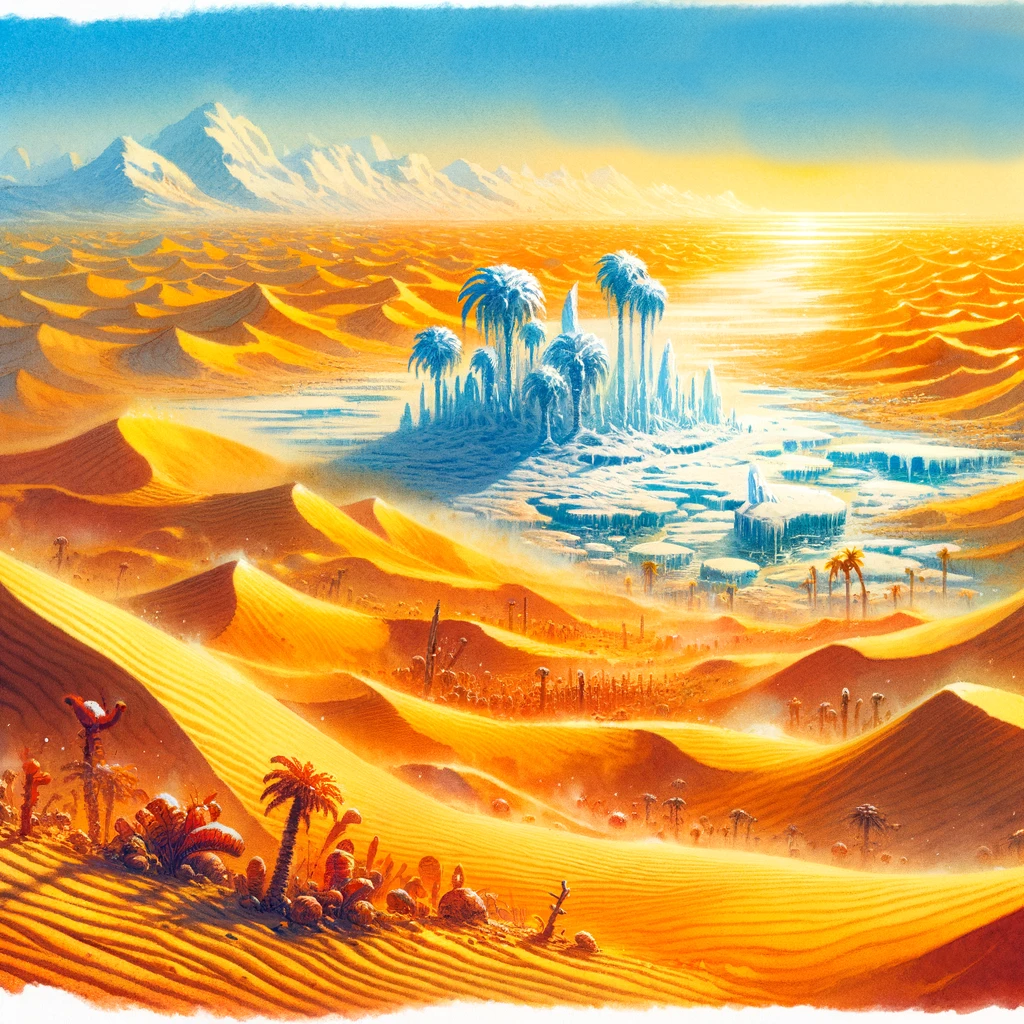
Deserts are common in the Outlands. These arid places experience little or no rain, but don’t have to be made from sand. Desert dunes are hill-like structures formed by the movement of dry terrain due to the wind. They tend to be shallow sloped on one side and steep on the other, and are difficult terrain to travel through. In the Outlands, where everything tends to be bigger and more vibrant, some desert dunes can be the size of small mountains. Some dunes of the Outlands are made from sand, but the chant goes there are also wandering dunes of snow, ash, silt, dust, salt, sparking smashed shards of mirror which reflect the light in dazzling patterns and even singing metal sands which chime in an eerie symphony as the wind blows. Watch out of the Oasis of Ice and Fire; in the midst of a particularly scorching desert there’s an oasis that’s somehow frozen solid, offering respite from the brutal heat. There’s also the Sea of Sand, a desert where the sand dunes ripple like the water, undulate and break like waves. It looks like water but you can step in and walk on top; the sands support your weight so you’re sort of floating. Thoth’s Estate is one of the best known desert lands; the power’s realm also includes the burg of Thebestys and the River Ma’at, which winds its way through the desert, bringing much-needed floodwaters twice a cycle to the farmlands that cling to the river like a Fated does to their coinpurse.
Fairy Circles
Fairy circles are eldritch rings of mushrooms, or flowers, or groves of trees or standing stones. Chant goes they might have slipped over from Arborea or come about when planar leylines converge. These sites are often ripe with gates to other planes, guarded by fey creatures or eladrin. The Drifting Stones fall into this category; these are ornately carved dolmens which move across the Outlands following their own inexplicable agendas.
Farmlands
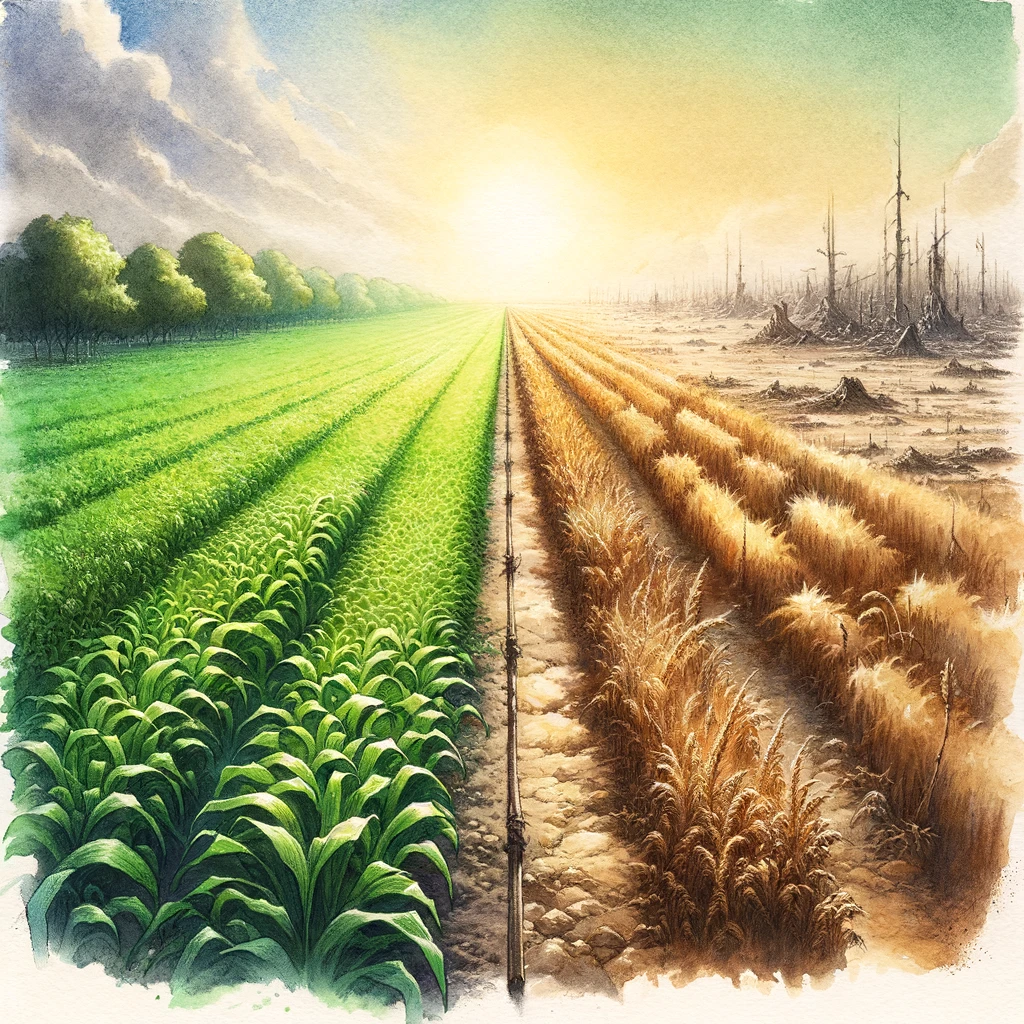
Farmlands and other cultivated agricultural lands typically appear near to burgs, especially the gate towns of the Upper Planes. The Outlands has many fertile valleys which produce grains, vegetables, vineyards and orchards. You can also find terraces cut into hills and mountains where cutters grow potatoes, or rice and taro in flooded paddy fields. The thing is though in these parts, farmers are a different sort. They don’t just farm the land; they’re custodians of balance. For every field lush with crops, there’s another one dusty and barren. The Outlands folk understand that for every grain they harvest on the fertile side, they need to tend to the barren side, revitalising it, ploughing back into the Land some of what they reap. It’s about give and take, see? You can’t have the bounty without the barren.
Forests
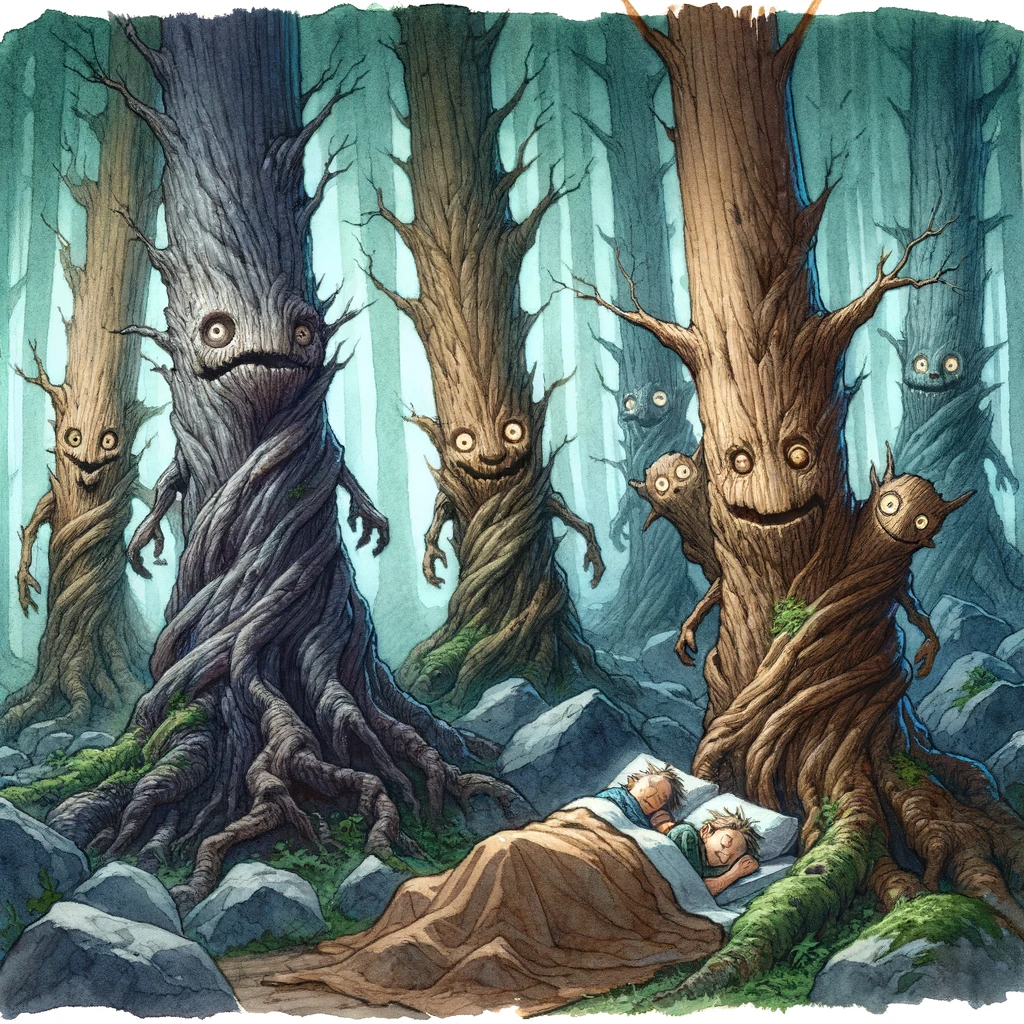
Forests and woods are common sights in the Outlands. We’ve talked before about their ambulatory habits—just because you go to sleep in a forest doesn’t mean it’ll still be there when you wake up. Forests can be made up from any kind of living tree, or cactus, giant sunflowers, razorvine, crystalline trees, fungus, needles of limestone. Watch out in particular for the Sneaking Forest, a particularly furtive band of trees that like to creep up on sleeping travellers and surround them before demanding water or the return of all wooden items. Or the Forest of Light and Shadow, where the glow from the sky somehow becomes the darkness and the shadows cast by objects glow with light.
Floating Islands
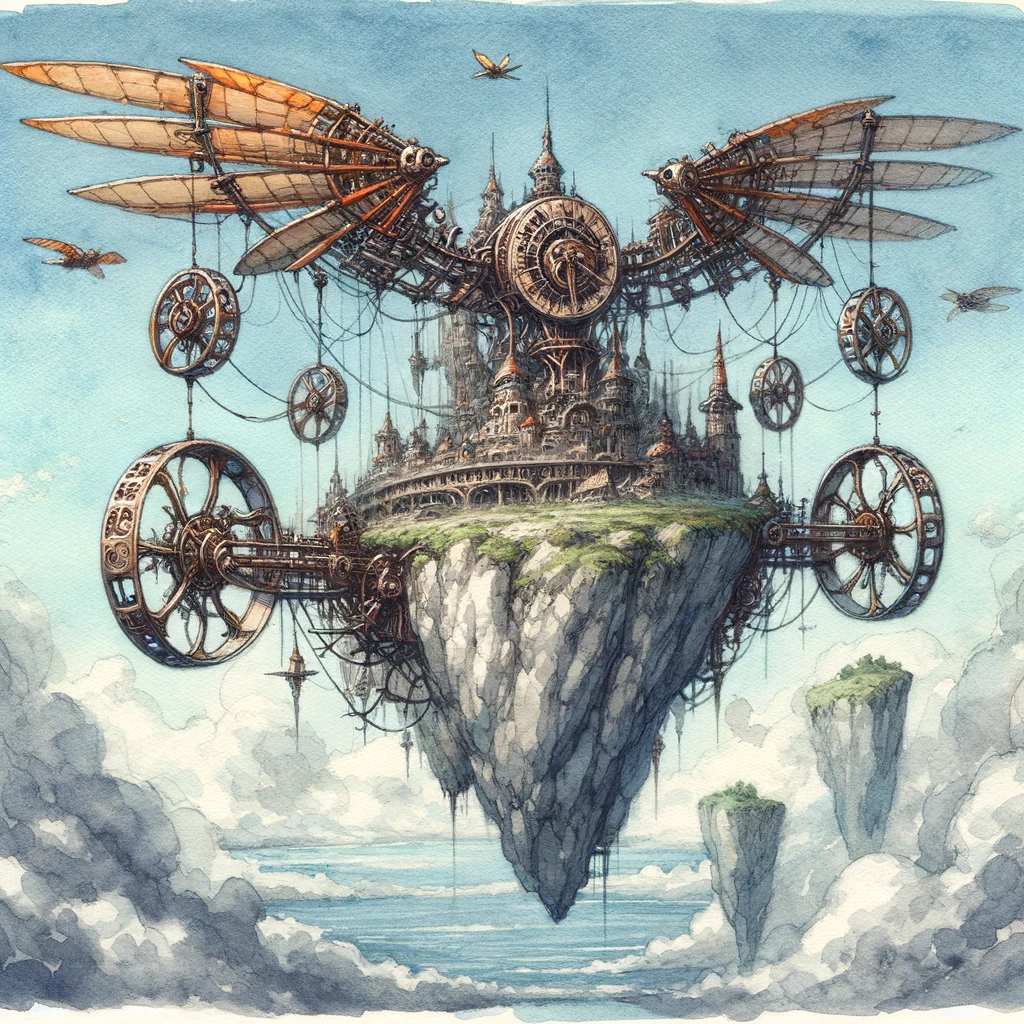
Floating Islands are rocky islands that defy gravity, apparently suspended in bodies of water or even the sky, bobbing around as the currents or breezes dictate or surrounded by clouds. Some can be navigated with giant sails or mechanical wings. Other floating islands have castles, inns or wizards’ towers upon them. Yet more are the lairs of flying beasts, aeries of aaracokra or planar dragons. Sometimes these islands occur in sky archipelagos, where islands cluster together in long chains, with waterfalls cascading from one to the next. The gate town of Itharin is one of the best-known floating islands.
Jungle
Jungles with tropical climates can be found, where a thick canopy of branches forms an second interconnected upper layer above the jungle floor of broad branches, vines and tree ferns, permeated by steam, clouds and the constant chatter of wildlife. But there is also the Petrified Jungle, where all organic matter has turned to stone, creating a maze-like network of stone vines and foliage. The Labyrinth of Life is a typical jungle realm of the Outlands.
Karstland
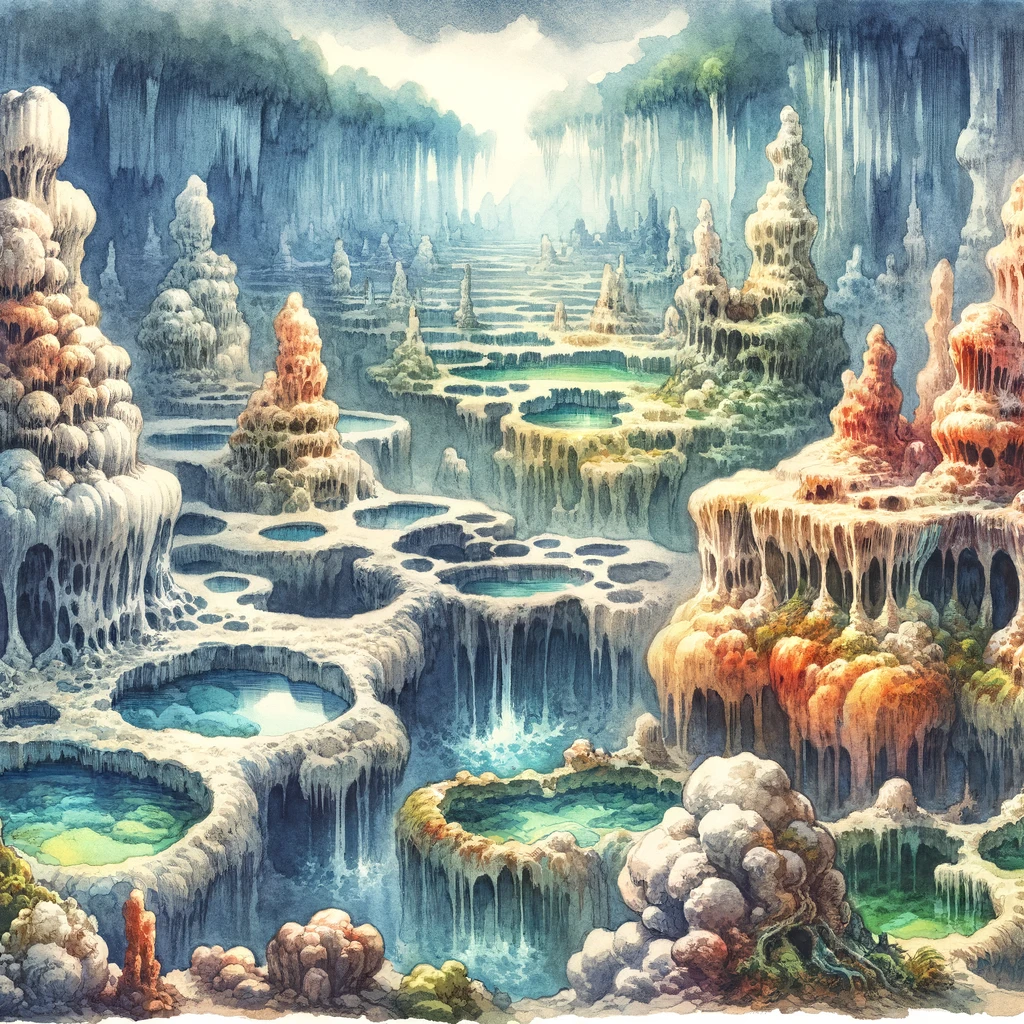
Karstlands are complex landscapes where soft rocks have eroded into bizarre formations. Watch out for sinkholes, underground rivers, caverns rich with stalactites and stalagmites, cenotes, acidic lakes, fairy chimneys and crystalline caverns.
Metallic Wilds
Metallic wilds are landscapes where the grass is made from fine chains of iron, chrome trees reflect dazzling light and copper flowers chime as they sway in the breeze. It’s a padfoot’s nightmare, making it almost impossible to sneak up on a cutter. And make sure you don’t fall onto a swordbush!
Misplaced Urban Terrain
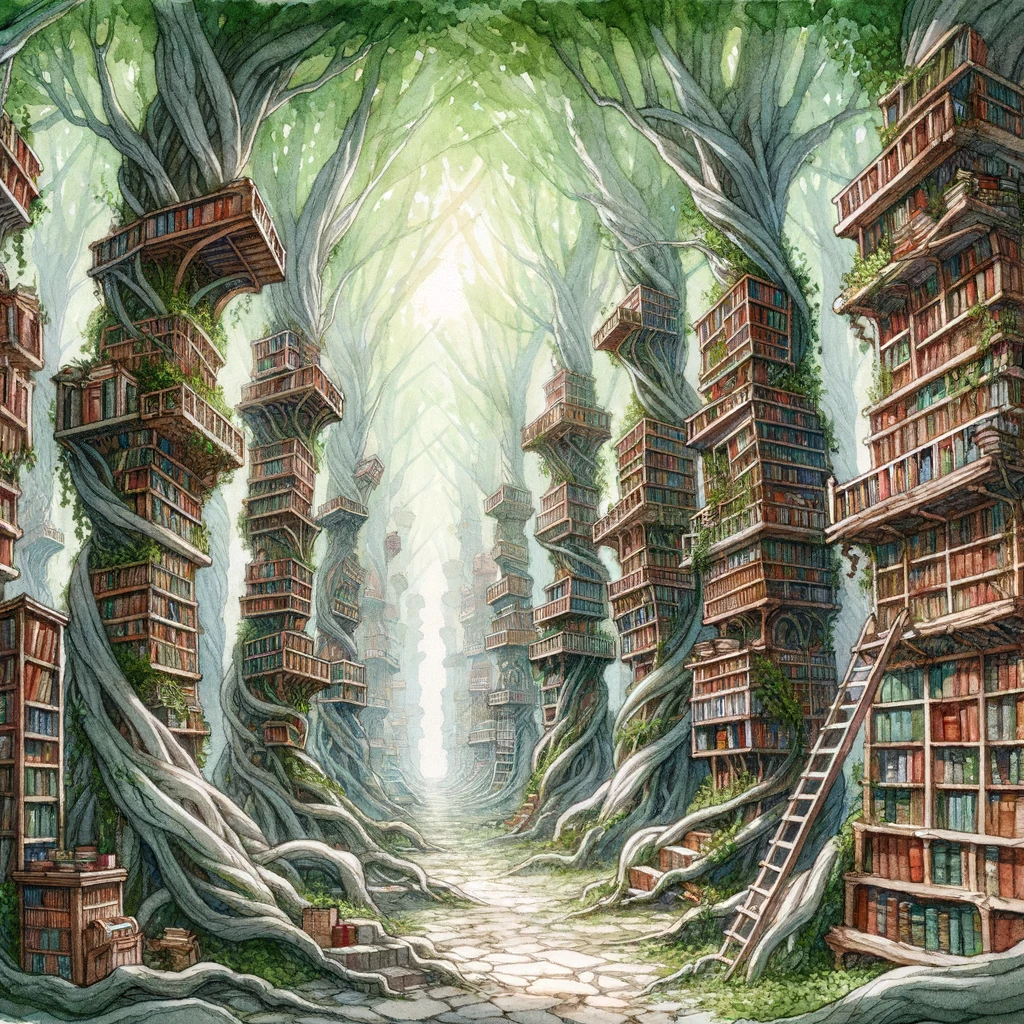
Misplaced urban terrain; now here’s a weird one. Some parts of the Outlands ain’t like the outdoors at all. You might round a mountain pass and find yourself in a landscape that’s basically an endless library, or the echoing halls of a temple, the ruins of an ancient city, or a labyrinth of doors. What’s especially unsettling is that these places are uninhabited; just forgotten about sand abandoned. Unless they’re not—if you’re really unlucky there will be some kind of monster there that’s made the place its home and doesn’t take kindly to intruders.
Plains
Plains are common throughout the Outlands. Some of them are even normal grass. As with all things Outlandish, the plains seem somehow wider, flatter, more expansive with bigger skies than you’d see in the Prime. Perhaps it’s something to do with the Spire making everything look smaller in perspective. You can also find the Starlit Savannah, where the grass and flowers emit a soft bio-luminescent glow resembling a starry night sky on the ground. Or the Whispering Plain, vast open grasslands where the winds carry votes from miles away. Don’t be surprised if you hear secrets meant for other ears here.
Reefs
Coral reefs are found, as you might expect, in large bodies of water like Tir fo Thuinn, but there are also stories of dry reefs, perhaps where the sea moved one way and forgot to take the reef with it. Intricate structures of bleached white pock-marked stone and shell, dry reefs are home to insects, birds or simply stand as start reminders of the fickleness of the Outlands terrain.
Rivers
Rivers in the Outlands don’t work the same as they do on the Prime. Obviously, they’re wider, deeper, faster flowing and so on. But they’re also unruly. We already talked about how they move around at night, approaching, receding, even changing course altogether under cover of darkness. Even during the day though, they’re odd. First, they don’t like to flow all in one direction. Some rivers for one way one day and the opposite the next, even if that means they go uphill. Other rivers have opposing currents, effectively going in both directions at once. Same goes for waterfalls; as the Sensates say, if you’ve not gone up a waterfall in a barrel, you haven’t lived. Also watch out for the Burning River, a river not of water but of blue liquid flames as hot as the heart of a forge.
Roads
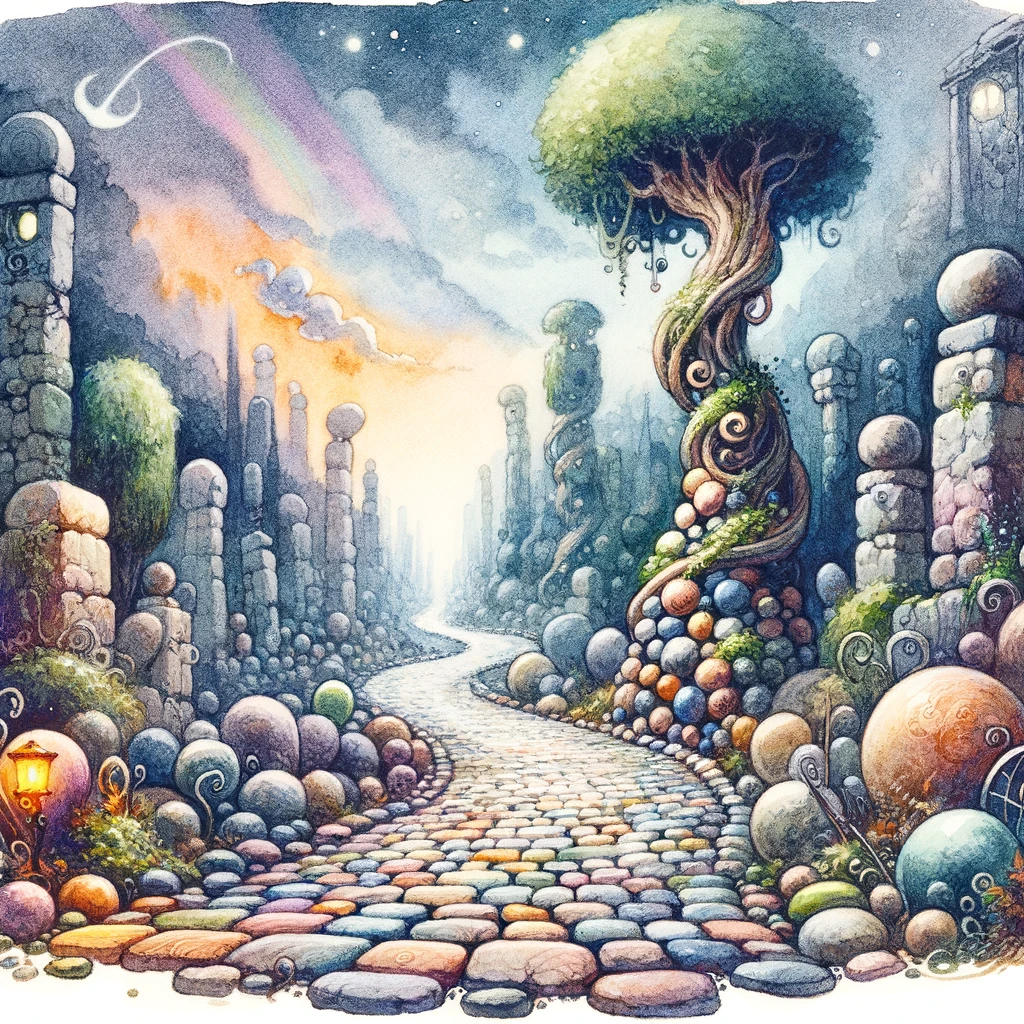
Roads and paths criss-cross the Outlands, connecting burgs to one another and to nearby sites of interest. It’s unclear who build these roads, for they’ve been there as long as any cutter can remember and nobody seems to maintain them. Little more than dirt tracks in places, but cobbled highways in others, sticking to the path is the surest way to find where you’re looking for without getting lost in the unstable wilderness. Although it does depend on the road. The Road of Stray and Stay is no ordinary stretch of flagstones. It’s a path that’s got its own ideas about where a cutter ought to be going. Here’s the dark: the road doesn’t care where you think you’re going. You might join it to get out of Bedlam—and who could blame you—and head towards Xaos. But the road has other ideas, and a sense of humour, and before long you find yourself back on the outskirts of Bedlam again. Or worse, Plague-Mort. The trick is to stop trying to steer your own course. If you wander without a destination fixed in your mind, before you know it you’re gliding along heading exactly where you need to be—even if it ain’t where you thought you wanted to go. It’s like the road’s telling you, “relax berk, I’ve got this”. Sure as Sigil, this road ain’t for the impatient or the headstrong; it’s for the dreamers and the drifters, cutters who’re willing to see where the journey takes them. If you try to rush things, the road’ll buck like a wild manticore.
Tundra
Tundra is typically found at higher elevations, and are typically areas of cold temperatures, low biodiversity, and a short growing season. At least on the Prime. The Outlands laugh in the face of what you might expect to see, and you can also find deep valleys of arctic tundra and permafrost landscapes rich with crystalline ice flowers. The tundralands are however a study in contradictions. You might be walking through a snowstorm but then suddenly find yourself in an area where the snows recede under your feet and give way to patches of vibrant, frost-resistant flora. You can find frozen hotsprings, where jets of water from deep beneath the land freeze on contact with the air, creating weird ice columns and sculptures. And whole forests submerged under snows so the trees look like weird shambling beasts. Be careful berk, because weird shambling beasts have worked out these are great places to hide and ambush careless delicious travellers.
Volcanoes
Volcanic landscapes are common around the gate town of Torch, where you’ll find hot springs, caldera, geysers, fumaroles and of course volcanoes. The Outlands of course throws its own twist on these terrains. Calmfire Volcanoes are towering mountains with peaks shrouded in smoke and fire, but the lava here flows slowly and cool, more like a gentle river than a raging inferno, the heat soothing rather than scorching. The Ash Forests on the volcanic slopes might look choked and dead but in fact the charcoal trees are alive, and the ground thick with soot actually nurtures life, a symbol of rebirth.
Wastelands
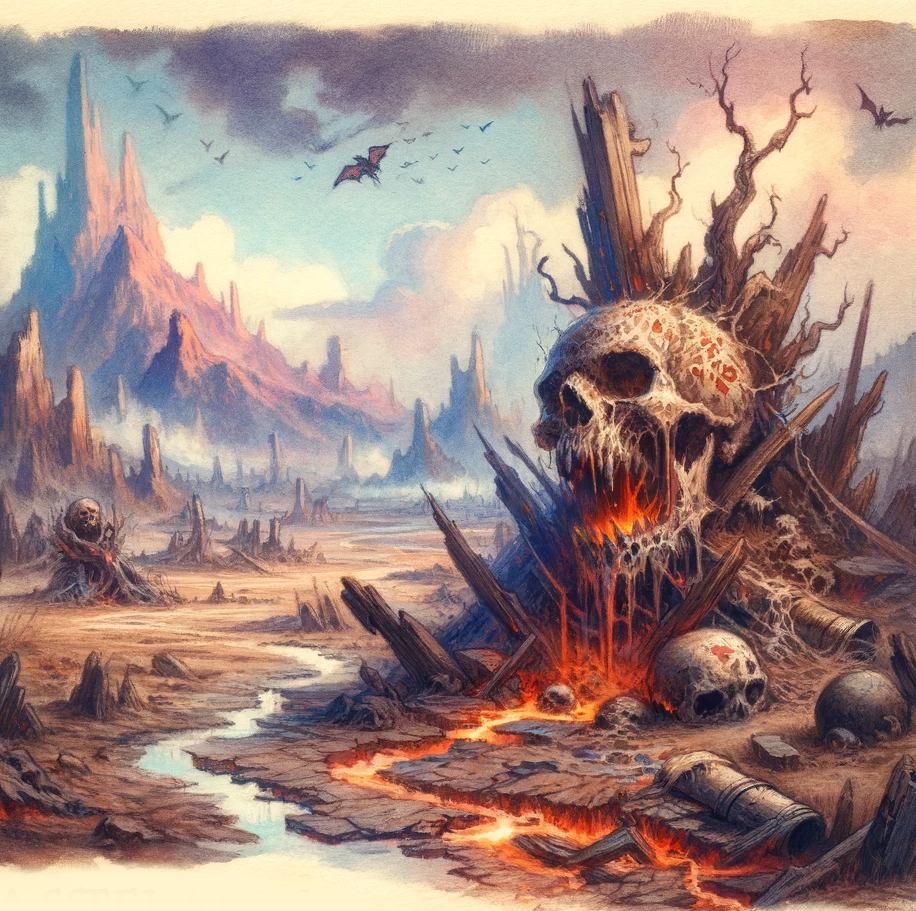
Wastelands are barren lands where magic has gone awry, with areas of wild magic, dead magic and dangerous arcane hazards and anomalies. Remnants of Blood War battlefields or planar subduction, these places are usually dangerous and always unstable, and travellers are warned not to tarry too long.
Wetlands
Wetlands like swamps, marshes, bogs, mangroves and fens are found all over the Outlands. These terrains are waterlogged, criss-crossed with canals, bayous and stagnant waterways. The temperature and types of vegetation determine what kind of wetland you’ll find. Semuanya’s Bog, for example, is a sprawling flooded forest, filled with lizard folk and even dinosaurs, which turns colder as you head Gloomward towards the Lower Planes.
Source: Jon Winter-Holt, mimir.net

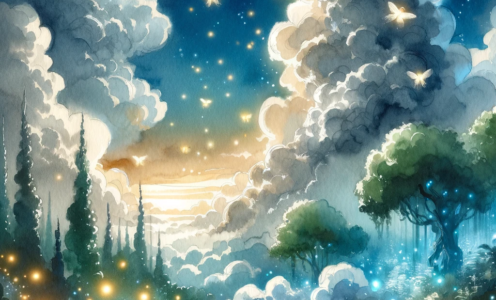
This is brilliant, yet to GM but no doubt will add a great deal of inspiration, thank you so much for sharing!!!
You’re most welcome, thanks for the feedback! I’ve got some more general Outlands atmosphere content to come soon on thinks like the sky, weather, petitioners and so on. Then I need to knuckle down and finish the remainder of the sites, powers and realms…
This (and SO MANY other pages on your site) is such an inspiration! I have taken my Forgotten Realms campaign (based on the legacy of the civil war in the kingdom of Athalantar) into the Planes, with my PCs needing to travel through the Outlands to Hopeless & into Oinos. I had written it up to arriving in the Outlands then hit a massive creative block, the 5e Planescape material being more of a hindrance than a help. But my problem is solved, all of this is wonderful stuff, thank you so much!
Hi Ed, thank you so much for the comment, it’s things like this that make all this stuff worthwhile. Good luck with Oinos, I haven’t spent much time thinking about the Gray Waste yet, hopefully the published material is a bit more evocative for that plane. One of the reasons I wanted to write up the Outlands is because I had the same feeling as you, as published it felt like a lot of fairly random places isolated 3d6 days from each other, and that was it… glad all my ramblings have been helpful!
Absolutely lovely! I’ve been sifting through this site for a few hours now, and it’s great fun! So much inspiring stuff, feels like sifting through a massive stack of wizard’s note clippings, haha!
I THINK I might have caught a typo on this page, unless it’s a chant thing, first line?
“So I’m guessing you already about”
Possibly missing a “know” there? OR perhaps I’m still getting used to the writing patterns!
Thanks very much! For the comments and the typos, should be fixed now. Keep ‘em coming please!
Cheers
Jonmimir